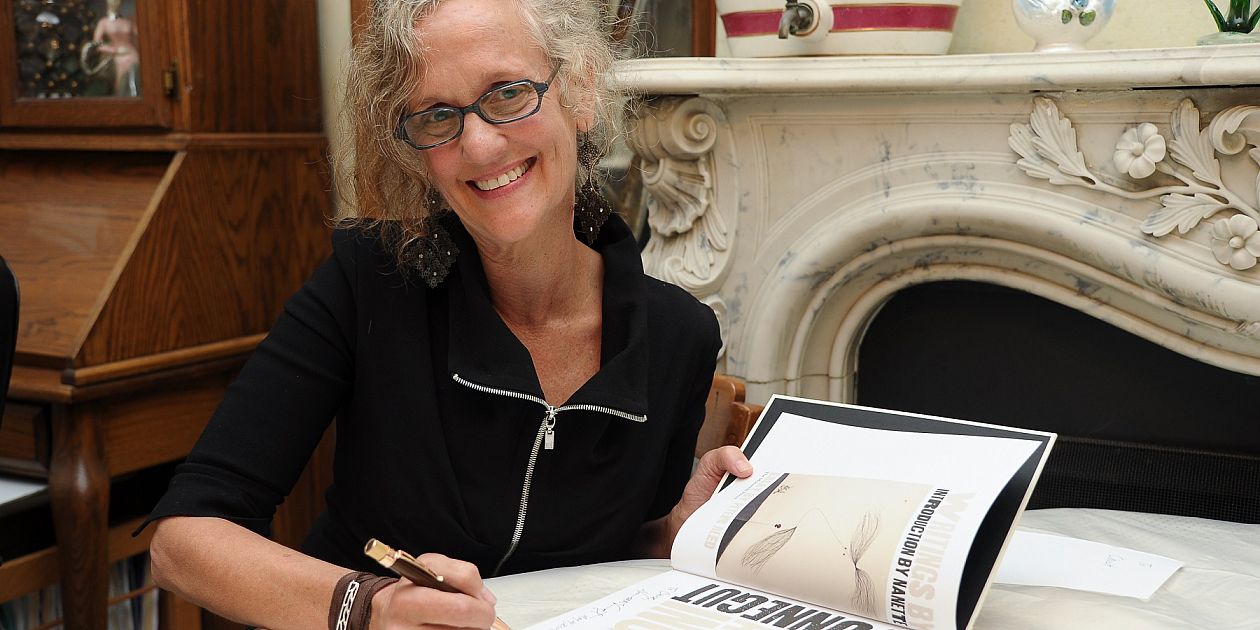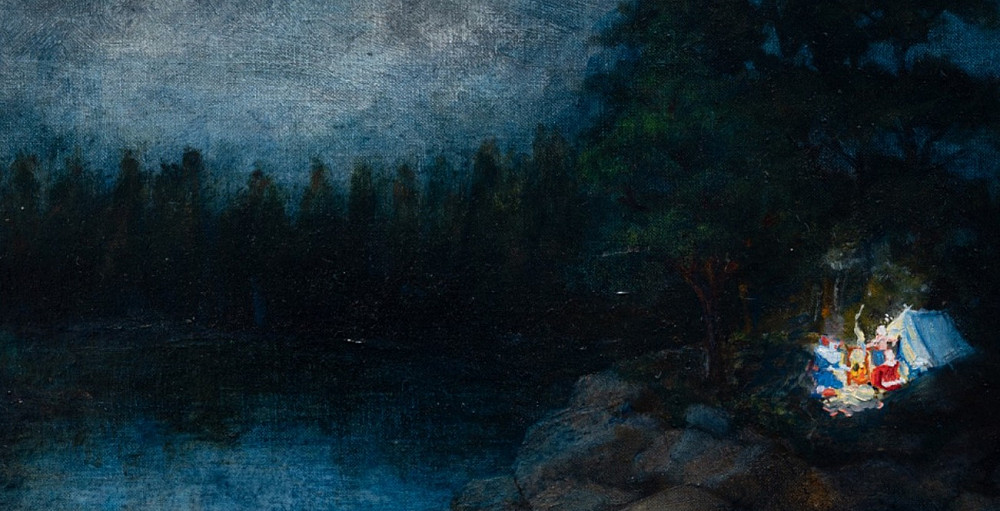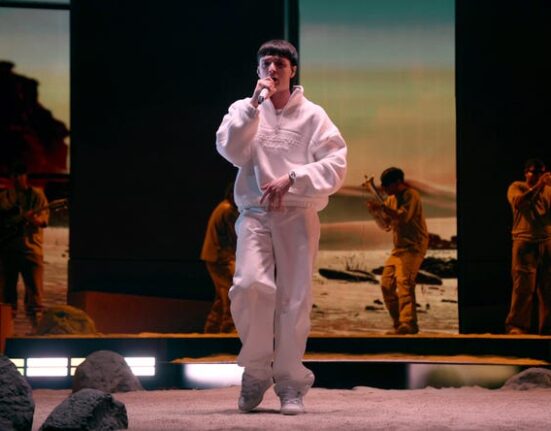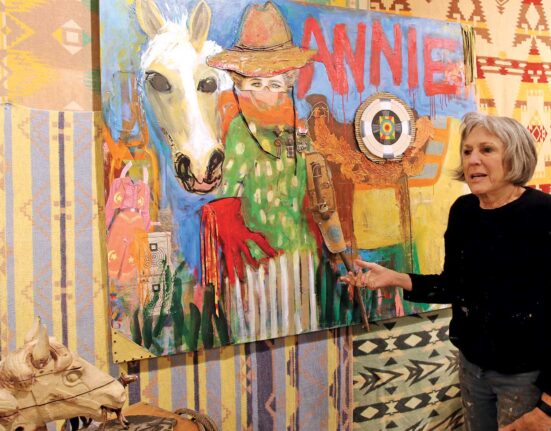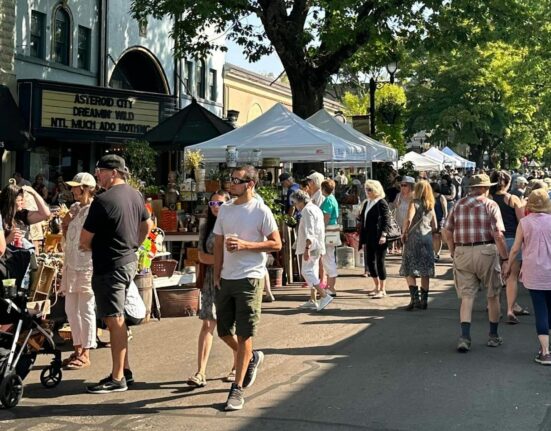The work of artist Nanette Vonnegut, the youngest child of Hoosier author Kurt Vonnegut Jr., can be seen this summer in the exhibition “Bad Math,” on display from May 20 to July 3 at the Gayle Karch Cook Center for Public Arts and Humanities on the Indiana University Bloomington campus. She will also deliver an artist’s talk at 5 p.m. June 6 at the Cook Center.
The exhibition is part of Granfalloon, an arts festival inspired by her father that brings together musicians, artists, thinkers and good people from all walks of life for a celebration of art, ideas and community. Nanette Vonnegut spoke with us about her art and memories of growing up with her father.
Question: How long have you been making art?
Answer: I grew up in a house where my father and my older sister were always doing artwork. My best friend and I would draw after school every day, so drawing was very much something I was always doing since I can remember. I learned how to have faith in the arts.
Nanette Vonnegut. Photo by Rommel Demano, Getty Images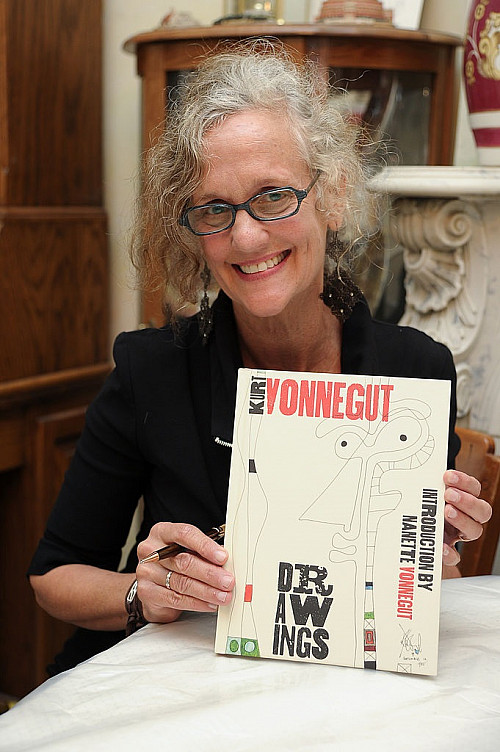
Every now and then my father would say, “You know, maybe you should be practical. You should learn how to type.” I’ll never forget it because that was part of growing up with my father. We took it for granted that this man went away into a room and was at a typewriter all day, tapping away. We didn’t know what he was doing, but we knew it was really important.
As you get older, you can look back and see at the time it was a very unstructured family life. It was kind of wild. Learning how to sew in middle school kind of saved my life and set a foundation for being an artist in much the same way that my father had to get stories in on time when he wrote for the newspapers in high school and at Cornell. He had to hit deadlines. He was very disciplined, so I learned that from him and from my mother.
I would say it was a romantic way to grow up, but there was also the discipline of this man who really worked hard at what he did. Looking back now, I just so admire it, and I have highest respect for anyone who can be that disciplined amidst raising children and not having any money.
Q: What other memories do you have of your dad growing up, and what kind of wisdom did he instill in you?
A: It was not until later that I looked up to and listened to my parents. As kids, we learned from each other. I mean, I learned more from my best friend Allison down the street. This isn’t a complaint, but parents now will go to great lengths to make sure their kids are getting educated and getting what they need, and it just wasn’t that way back then.
It was a huge deal living with a creative force like my father. You had to learn how to move around it, and I think it sort of affected me in that I wanted the same thing. I learned I didn’t want to be the person guarding the artist. My mother was also a very talented writer, but she was devoted to my father and guarded his time and his space. I learned about what it is to be a writer. It’s really rough but so worthwhile.
Q: What inspires your artwork?
A: Looking at other art is inspiring. I can’t live without going to museums or looking in books.
One piece in the show is of the Young@Heart Chorus. I did a very large grid pattern painting of it. I was inspired watching Bob Cilman, who’s the director, have these Zoom meetings with the chorus. It was maybe 30 people on the Zoom, and I’m looking at all the faces and people talking. It just so excited me, and I asked him to send me the stills from the Zoom.
It sounds corny, but love is a great motivator. The affection for those people on the chorus and for what Young@Heart represents, it’s just an amazing concept.
Each piece is very personal. There’s another one called “Pete’s View” that honors a friend who died of cancer right before the pandemic. I didn’t know him for very long, but he was an incredibly special person. His partner sent me the last photograph Pete took, which was of a radiant tulip. It was a meditation on him, thinking about him and wanting to just spend time with him.
Q: I really loved the rooms that you painted. Can you tell me more about those?
A: That was way back when I had young kids. When my first child was a baby, I wanted to do a portrait of him asleep in his crib in his bedroom. “Bad Math” applies to that because I don’t know how I made the rooms work, but they sort of did. It’s a cockeyed bird’s-eye view.
Q: Did you ever live in Indiana while growing up?
A: No, but you know what, it’s weird because I feel like I did. I can’t explain it. I grew up on the cape in Barnstable, Massachusetts. My parents had this romantic idea of moving to the cape and going to Provincetown because Norman Mailer was there, so they spent some time in Provincetown and then found whatever they could afford in Barnstable. It started with this idea of being around other writers.
Recently, when I’ve gone back to Indianapolis, I have felt something powerful, actually. I go to Crown Hill Cemetery. I seem to be the one in the family who likes to go to the grave sites because I feel a profound connection. I don’t know if somebody is trying to talk to me from my past.
That idea is in a lot of my artwork too — honoring, in particular, the women in my family tree on both sides because they got short shrift as women do. They became marginalized and had reputations that they were crazy, or that they killed themselves or that they died in childbirth. So I was very curious about them and got to know more about them, and they show up in a lot of my prints that will be in the show.
The original draft of the Student Building, designed in 1905 by Bernard Vonnegut Sr. of the Vonnegut & Bohn architectural firm based in Indianapolis, shows plans prior to adding a clock tower to the final design. Photo courtesy of IU Archives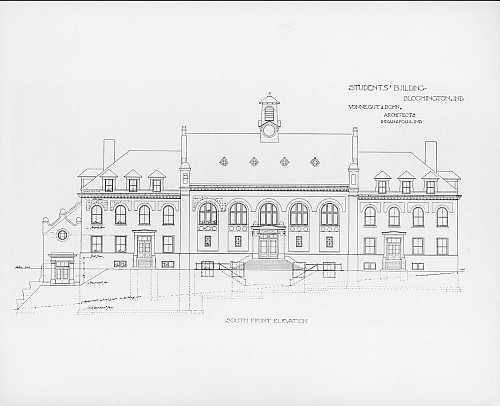
A: You know, I was with my father when the documentary was being made about him. I came along for that, and he would point out like the clock on the L.S. Ayres building that my grandfather designed, and he had to do some crazy engineering to make it work. There’s so much creativity that goes way back.
The house on Illinois Street in Indianapolis just totally captivated me. There are so many details that my grandfather installed there, like the stained glass with his and Edith’s initials on the front door. Seeing my father in that house, he became almost like a boy again, like he went back in time. It was a very happy time for him there.
I’ve had profound moments in Indianapolis with my father. Midwesterners are very friendly. It’s a different sensibility.
Q: Granfalloon is this eclectic festival that brings together musicians and artists and thinkers and just good people from different walks of life to celebrate art, ideas and community. Do you think that your dad would have enjoyed Granfalloon?
A: Yes, he would have had a good time, but he was not somebody that would just sit back for the day. He was always looking for the backdoor.
He was very appreciative of artwork, and he enjoyed talking about my art with me. It was always very funny. After one art show that I had a lot of fire in, he said “You know, you might as well just set everything on fire.”
He loved music. He loved jazz. My father was also a real ham. If you gave him an opportunity to get on stage and recite Chaucer, which he did once when he was in town, he was an incredible performer. He and my mother used to be in plays together.
What would have been perfect, were he here now and could visit Bloomington, would be to have him show up on the stage and do something like that. He would have loved that.

